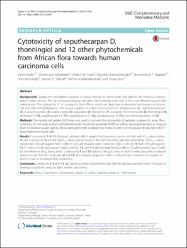Cytotoxicity of seputhecarpan D, thonningiol and 12 other phytochemicals from African flora towards human carcinoma cells

Göster/Aç
Erişim
info:eu-repo/semantics/openAccessTarih
2018Yazar
Kuete, VictorNgnintedo, Dominique
Fotso, Ghislain W.
Karaosmanoğlu, Oğuzhan
Ngadjui, Bonaventure T.
Keumedjio, Felix
Sivas, Hülya
33 readers on Mendeley
Üst veri
Tüm öğe kaydını gösterÖzet
Background: Despite the remarkable progress in cancer therapy in recent years, this disease still remains a serious public health concern. The use of natural products has been and continues to be one of the most effective ways to fight malignancies. The cytotoxicity of 14 compounds from African medicinal plants was evaluated in four human carcinoma cell lines and normal fibroblasts. The tested samples included: beta-spinasterol (1), friedelanone (2), 16 beta-hydroxylupeol (3), beta-amyrin acetate (4), lupeol acetate (5), sequoyitol (6), rhamnitrin (7), europetin 3-O-rhamnoside (8), thonningiol (9), glyasperin F (10), seputhecarpan B (11), seputhecarpan C (12), seputhecarpan D (13) and rheediaxanthone A (14). Methods: The neutral red uptake (NR) assay was used to evaluate the cytotoxicity of samples; caspase-Glo assay, flow cytometry for cell cycle analysis and mitochondrial membrane potential (MMP) as well as spectrophotometry to measure levels of reactive oxygen species (ROS) were performed to detect the mode of action of compounds 9 and 13 in MCF-7 breast adenocarcinoma cells. Results: Compounds 3, 9-13 displayed cytotoxic effects against the four tested cancer cell lines with IC50 values below 85 mu M. Compounds 9 and 13 had IC50 values below 10 mu M in 4/4 and 3/4 tested cell lines respectively. The IC50 values varied from 0.36 mu M (against MCF7 cells) to 5.65 mu M (towards colon carcinoma DLD-1 cells) for 9, from 9.78 mu M (against MCF7 cells) to 67.68 mu M (against HepG2 cells) for 13 and 0.18 mu M (towards HepG2 cells) to 72 mu M (towards Caco-2 cells) for the reference drug, doxorubicin. Compounds 9 and 13 induced cell cycle arrest in Go/G1 whilst doxorubicin induced arrest in G2/M. The two molecules (9 and 13) also induced apoptosis in MCF-7 cells through activation of caspases 3/7 and 9 as well as enhanced ROS production. Conclusion: Compounds 9 and 13 are good cytotoxic phytochemicals that should be explored more in future to develop a cytotoxic drug to fight human carcinoma.

















